Mashable, ProBlogger, and KISSmetrics didn’t reach millions of people by accident. Their founders were smart, or more importantly, had smart strategies.
In researching this article, I found out that Mashable wrote one article last month that generated more links and shares than 87 of their posts from 2013 combined. I found out how KISSmetrics systematically increased their weekly traffic by 18.6%. I also learned how unconventional strategies, such as building a blog in Asian languages, opened the floodgates to millions of visits in under six months.
This post is about effective blogging, and going beyond the 80/20 rule to reach the 52/1 rule, where 1% of your effort drives 52% of the outcome. Knowing your 1%, like these bloggers did, is one hell of a competitive advantage.
How Mashable reached two million readers in 18 months
Pete Cashmore launched Mashable.com at age 19 and grew it to two million readers within 18 months. In the first year, he worked 20 hour-long days writing articles about technology – with no advertisers. In 2012, Mashable was valued at $200 million.
Mashable.com had the advantage of being an early adopter in a rapidly growing industry that was becoming of mainstream interest. But what really stood out was how frequently Pete blogged from the very start. A look through their archives shows that in the early days Pete would write between 1-5 blog posts per day, usually averaging two or three a day.
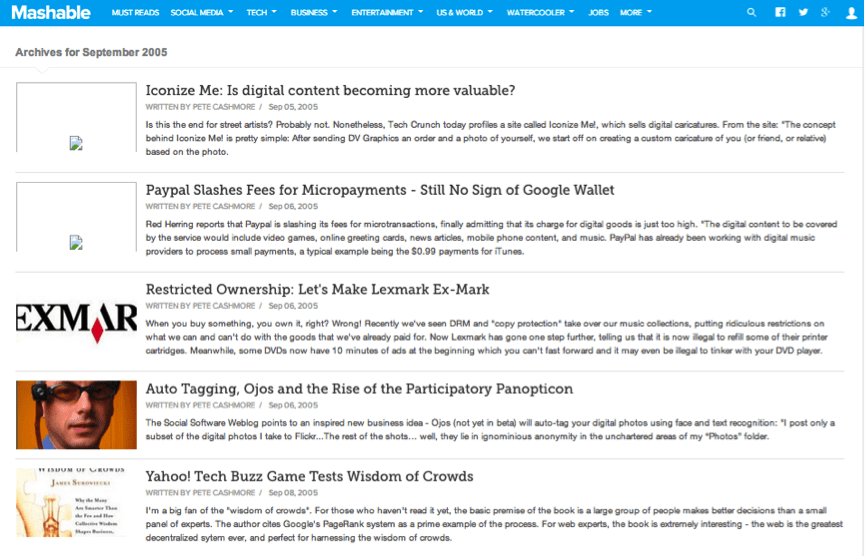
In an interview with Inc.com, Pete explained that his persistence was fueled by an obsession over seeing his numbers increase, and a lack of desire to go to university or be employed.
“I would look at the stats everyday and say, “Have I beaten yesterday?” And almost every day I would have beaten yesterday in terms of the number of people who were reading the site. So, that kind of kept me going.” – Pete Cashmore
Within two years, Mashable established itself as the leading blog in technology and digital media and had built an audience of over two million monthly readers. Today, Mashable attracts 10x the amount of traffic it did back then, so how did they bridge the gap from 2m visitors to 22m visitors?
Mashable hired 43 editorial staff members, increasing their editorial output from 1-5 articles to 7-15 articles per day. They also shifted their focus towards infographics for a few years (they’ve posted over 900 of them), and started ‘utilising‘ their domain’s strength a bit more.

While controversial (but not unusual), Mashable.com have been able to exponentially grow their traffic by ranking for the names of the brands that they write about. With over 35,000 indexed category pages, Mashable generates millions of visits from people searching in Google for brands like ‘Facebook’, ‘Twitter’ and ‘Gmail’. In fact, the keyword ‘Facebook’ is the highest traffic-driving keyword to Mashable.com.
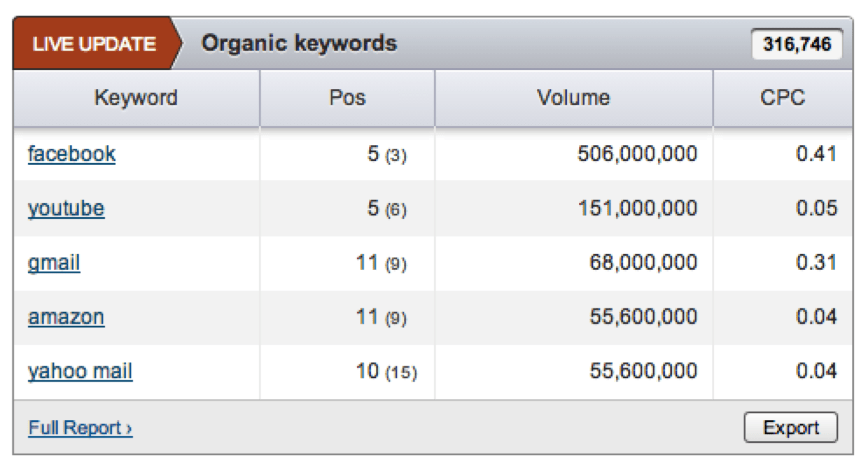
So what can we learn from Mashable.com’s growth?
To me, the key lessons here are persistance, frequency, and timing. If Pete launched Mashable.com today rather than in 2005, I doubt it’d be anywhere near as successful, his timing was great. But lots of other tech blogs were also launched in or before 2005 – that’s where frequency and persistance set Mashable apart.
How did ProBlogger reach millions of readers?
Since launching Problogger in 2004, Darren Rowse and his team have posted over 8,000 blog posts. What’s particularly impressive is that Problogger is just one of 20 or so blogs that Darren runs.
Darren puts his success down to a combination of being among the first to blog about blogging, writing actionable content, having authenticity, and sticking to it over the long run. Oh, and he also had a motivating ultimatum from his wife:
“You’ve got 6 months to make blogging full time” – Darren’s wife
So what did Darren do that worked so well?
Like Mashable, Darren grew Problogger by writing superhuman volumes of content (5-10 posts per day). Over the years, this accumulated to become an archive of 8,000+ individual articles. However, unlike Mashable, Problogger focused on creating evergreen content (content that does not go out of date), not topical news.
Because of this, Problogger has been able to reduce their posting frequency to 3/4 articles per week, while still maintaining traffic growth. Using tools like Social Crawlytics and Open Site Explorer, we can clearly see that Darren’s highest-performing content is nothing but actionable and helpful resources that will remain relevant for a long time.
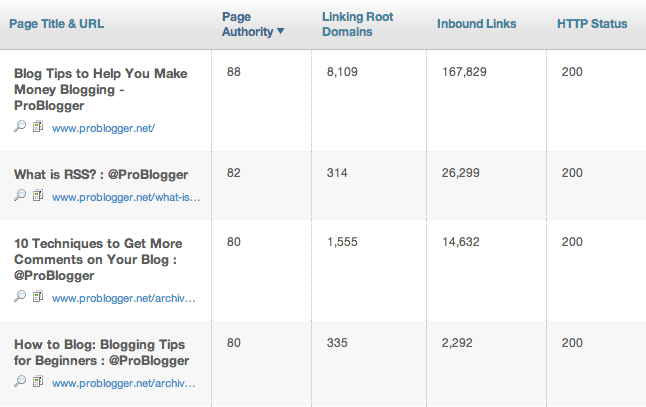
So, there we have another strategy for building a 7-figure blog audience. By being helpful and providing other bloggers with actionable tips, Darren’s slow and steady approach ultimately attracted millions of visitors, and established him as one of the most authoritative bloggers in the World.
“The key to success in blogging (and in many areas of life) is small but regular and consistent actions over a long period of time.” – Darren Rowse
How a Japanese blog reached 1.4m readers in six months
To mix things up a bit, I thought I’d shine the spotlight on a really fascinating case study, by Nick Eubanks, on how despite not speaking Japanese, he built a Japanese blog that almost broke 100,000 visitors in the first month after launch, and reached 1.4 million visits in just six months.
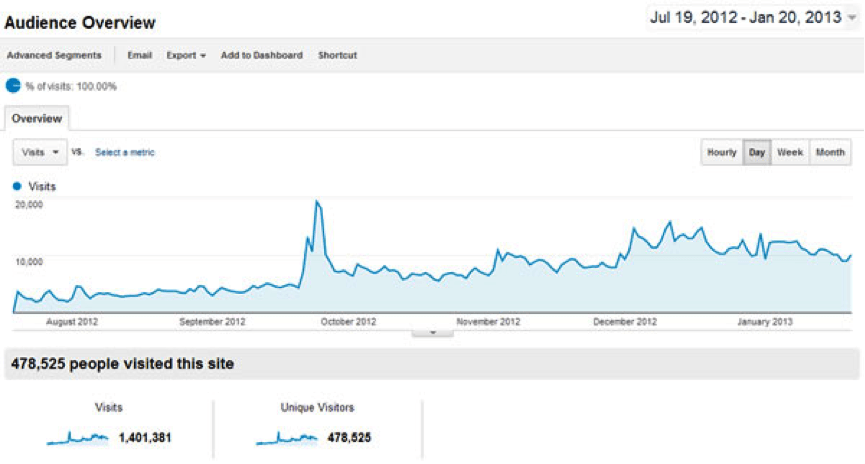
While the identity of the website is undisclosed, we do know that it targeted the Japanese market.
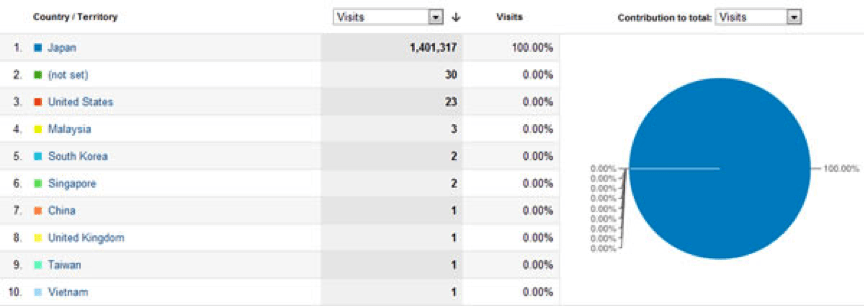
Nick’s strategy was based on a mathematical approach of building an algorithm that weighted the opportunity and difficulty of over 50,000 Japanese keywords. From there, Nick’s team identified the top 100 keywords and then calculated which ones would generate the highest returns in a short period of time.
In other words, he applied the 80/20 rule to the 80/20 rule of SEO to find the absolute minimum amount of work needed to generate huge results, and it worked.
While this may seem very different to the other strategies we’ve deconstructed, it’s not all that different to be honest, just more precise.
Nick knew that a high frequency of posting was important, so he posted 2-4 pieces of content per day. He also capitalised on topical content, but not by writing about breaking news, but instead by writing about events that were sure to happen, in advance.
The result of Nick’s planning strategy meant that he was able to achieve an amazing result in very little time by working smarter, not harder, than his competition.
How GetRichSlowly.org reached one million readers per month
Since launching GetRichSlowly.org in 2006, JD’s become a TIME Magazine Top 25 Blogger and has grown his blog to receive over one million monthly visitors.
What’s interesting about JD is that he’s the self-proclaimed “worst marketer in the World“. In an interview with Maneesh Sethi, JD admitted to never paying much attention to SEO or any of the trends that his blogger friends used to tell him about. Even today, GRS’s design is outdated, the site’s SEO is mediocre, and there’s loads of room for optimising sign-up rates. But none of this matters to JD – because his strategy is simple. His strategy is content is king.

For years, JD posted 1-10 posts per week, offering excellent personal finance advice. A deeper dig into what spurred the blog’s success suggests that his most shared and linked-to content is, similarly to Problogger, actionable evergreen content.
So like the Problogger story, JD succeeded by being useful for long enough that his blog reached a tipping point and became the authority in his niche. Best of all, JD debunks the myth that you need to be a good marketer to build a popular blog.
How ConversionXL reached 1,000,000s of readers
ConversionXL is one of my favourite blogs about conversion optimization. It took Peep Laja just over a year to get ConversionXL past the 100,000 visitors / month mark.
Similar to Nick’s approach, prior to launching ConversionXL, Peep did a considerable amount of planning and research to identify what niche he wanted to write about, and what kind of content would generate results. He concluded that there was a gap in the market for an evidence-based, data-driven marketing advice blog that focused on conversion optimization.
What’s interesting about Peep’s approach is that he didn’t post frequently. For the first year, he averaged one post every 4.8 days. Then it slowed down to once every two weeks.
Peep’s success came from picking an interesting niche, writing highly linkable and shareable content, and getting lucky with a few viral hits.

Peep’s case once again highlights the benefits of planning ahead and working smart.
How KISSmetrics reached 2.5 million+ readers in 20 months
It took Neil Patel twenty months to get the KISSmetrics blog to over 100,000 monthly readers. According to a write-up on his blog, Neil started by writing two posts per week on KISSmetrics – but the blog didn’t really see any significant uplift in traffic until he increased this frequency to five posts per week.
From there he experimented with six posts and noticed an 18.6% increase in traffic for writing one additional blog post per week.
While this growth isn’t as aggressive as some of the earlier blogs reviewed, it’s worth bearing in mind that Neil also runs Quicksprout and CrazyEgg, both of which have blogs with a 7-figure readership.
How has Neil repeatedly built 3x blogs with millions of readers?
Well, there’s the recurring theme of frequency and consistency. Neil’s also seriously hard working – the guy’s output and energy is borderline superhuman, so we should probably take that into account. Besides these intangibles, what specifically made KISSmetrics so successful?
Like Mashable, KISSmetrics had a lot of success with infographics. In two years, they created 47 infographics, which generated 2,512,596 visitors and 41,142 backlinks from 3,741 unique domains.
On top of this, KISSmetrics receive 6% of their blog traffic from emailing subscribers about new posts.
I have no doubt that the lesser-mentioned ‘secret sauce’ to Neil’s success is also the compounding ease and quality/magnitude of cross-promotions and partnership opportunities. By owning two digital marketing technology companies, an agency, and his own marketing blog, i’m sure there’s a lot of leverage between the various lists, client relationships, and case studies.
What we can learn about building a 7-figure audience
What I found so fascinating while researching this post was how varied the approaches were for each of the blogs, yet how many similarities they shared. It shows how the opposite of what works can also work.
While everyone will take away something a bit different, this is what I took away:
- Building a blog takes time – your traffic will plateau, then grow, then plateau…
- This time can be reduced through careful planning
- Discipline is essential. You need to stick with it for a long time
- If you want to compound traffic without lots of staff, write evergreen content
- Timing and niche-ing are fundamental if you want to be #1
- Work smarter, not harder.
But the most difficult and upraised step that all of these successful bloggers took is getting started. If you want to follow in the footsteps of these successful bloggers and haven’t yet started – I urge you to do so today. If you’re not sure how to do so, you can follow our guides on how to find the best web hosting, and then a guide on how to start blogging.
Best of luck.




